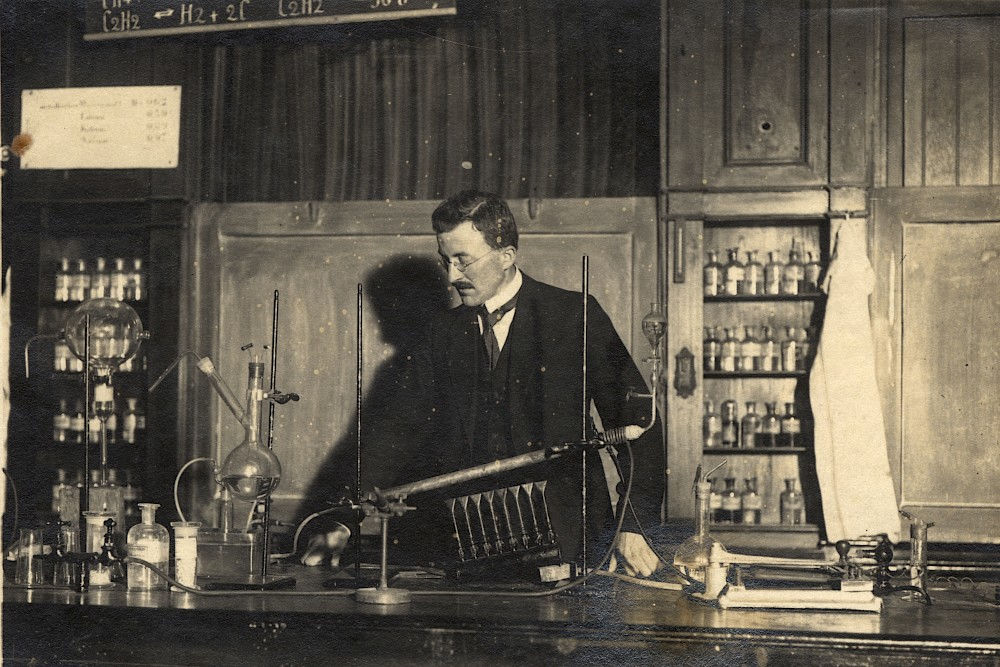Big names: Hermann Staudinger

A great number of Nobel laureates have been defined by their firm belief in their work – even in the face of opposition. A good example is Hermann Staudinger, a scientist who was awarded the Nobel Prize in Chemistry in 1953 for his developments in the field of macromolecular chemistry. It had taken many years for his groundbreaking theory to gain acceptance – many years in which he defended his work despite everything.
As early as 1920, he became the first person to describe a new class of substances with completely new properties. He demonstrated how small molecules, so-called monomers, can combine to form larger molecules, so-called polymers. He continued to work intensively with so-called “macromolecules” in the years that followed. He coined this term himself and used it publicly for the first time in 1922. His findings paved the way for polymer chemistry, which is used in almost all areas of modern life. Synthetic plastics, such as nylon used to make tights and PVC found in laminate flooring, were quick to catch on and become mass-produced goods that everyone knows.
However, what many people don’t know is that Staudinger received his scientific education at the University of Halle.
Interest in botany
He first enrolled at the Friedrichs University Halle in 1899. His name can be found in the oversized, leather-bound enrolment books that are still kept in the university archives. Staudinger registered for the autumn semester by hand on 17 October 1899. According to documents, the 18-year-old son of the grammar school teacher Franz Staudinger and his wife Auguste moved into lodging at Bernburger Strasse 28a. He had previously met his father’s wishes by training to become a carpenter, but he actually wanted to become a botanist, as evidenced by various entries in his study diary, which is also kept in the university archives.
Staudinger returned to Halle after a brief spell at the universities in Darmstadt and Munich; his name can be found again in the enrolment list for 1902. This time, he moved to Laurentiusstrasse. He was studying for a doctorate. His thesis was entitled “The Attachment of Malonic Ester to Unsaturated Compounds”. His supervisor was none other than Professor Daniel Vorländer, who was directing the Institute of Chemistry and working on liquid crystals at the time.
Staudinger’s examination records can still be viewed today. We can see that he took his doctoral examination at the Faculty of Philosophy on 27 February 1903. In the oral examination (rigorosum), he was asked about two major topics: chemistry and botany. The historical documents would suggest his results were even above average back then. Professor Alois Riehl, one of the university professors in attendance alongside the dean Professor Wilhelm Dittenberger and privy government councillor Professor Jacob Volhard, noted in the report that he had presented the candidate with some “difficult questions”. According to the report, he demonstrated very good knowledge in all areas. He achieved the grade “Magna cum laude”.
After obtaining his doctorate, Staudinger worked as an assistant at the University of Strasbourg. He accepted a professorship at Karlsruhe in 1907 before switching to ETH Zurich in 1912, and he eventually became a professor at the University of Freiburg in 1926. There, too, he initially had difficulties in getting people on board with his new theory on macromolecules; many of his expert colleagues still had their doubts. His work was only verified in the 1930s by a pair of chemists from IG Farben in Ludwigshafen. Kurt Meyer and Herrmann F. Mark had previously managed to prove the existence of long molecular chains using X-rays in the laboratory. However, their verification was preceded by a long dispute in which Meyer and Mark had even taken an aggressive stance against the chemist.
Staudinger’s strong and unwavering belief in his theory might have had something to do with the woman by his side. In 1928, he married Magda Voits, a chemist and botanist who was born in Latvia and researched macromolecules and their chemical structures with him. When her husband subsequently founded a journal for macromolecular chemistry, Magda Staudinger became a member of the editorial board. Following the death of her husband in 1965, she published his collected works. She must have had a big influence on his work, as he made an explicit reference to her when he received the Nobel Prize in 1953. In his speech, he expressed his “deepest, heartfelt gratitude” to the members of the Royal Swedish Academy of Sciences and the Nobel Foundation: “I would also like to thank you on behalf of my wife, who has been my colleague in this field for many years”.
Centenary of polymers
Staudinger has edged into the political spotlight in recent years: A commission of historians in Freiburg discussed his ambivalent role during the Nazi period as part of a debate regarding the renaming of local streets that began in 2013.
From a scientific perspective, however, the chemist’s merits are undisputed. Experts are now holding special events and publishing commemorative articles to celebrate the centenary of polymers based on Staudinger’s work. Since 1971, the German Chemical Society has regularly awarded the Hermann Staudinger Prize to outstanding polymer researchers. And in 2011, the Collaborative Research Center SFB/Transregio 102 "Polymers under multiple constraints" was established at the University of Halle, where the scientist began his career.
Big Names
The University’s history connects it to many well-known figures or big ideas. Not everyone, however, is fully clued up on the whys and wherefores of these connections. But that’s about to change. The section, “Big Names” is a reminder of the outstanding researchers and academics who have links to the City of Halle.
